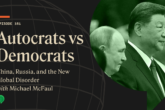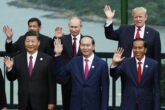October 21, 2022
Assessing Russian State Capacity to Develop and Deploy Advanced Military Technology
Introduction
Even before Russia’s invasion of Ukraine in February 2022, many analysts and policymakers viewed Russia as a declining power. This mindset, formed by the sharp juxtaposition between the seeming strength of the Soviet Union and the chaos and weakness of Russia in the 1990s, has been an enduring heuristic for how Russia today is understood. The country’s stagnant and resource-dependent economy, declining population, and substantial brain drain have fed a sense that Russia’s days as a global power are numbered. The war in Ukraine has only accelerated some of these trends, further reinforcing such views. The Russian military’s poor performance, the degradation of its forces, and the imposition of sanctions and export controls that will restrict Russia’s ability to regenerate its forces have already led some to dismiss the country as a Potemkin power and pronounce the end of its great power status.1
Russia undoubtedly will emerge from its war on Ukraine as a weaker power. But even during the post-Soviet period of sustained economic stagnation, brain drain, and demographic decline, the Russian state developed a new generation of hypersonic missiles, air and missile defenses, and nuclear weapons with novel means of propulsion. Russia has demonstrated that it is able not only to bring to fruition late-Soviet designs, but also to develop a follow-on generation of capabilities. Likewise, the Kremlin has continued to modernize and expand its nuclear capabilities.
Moving forward, as a result of its invasion of Ukraine, Russia will face new and more significant constraints on its ability to modernize its military. But it is too soon to count Russia out.
Despite economic constraints, the Kremlin prioritized the development of its strategic nuclear forces by investing significant resources into developing and deploying new nuclear warheads and launchers, upgrading all legs of the nuclear triad, completing work on a hypersonic glide vehicle, and building a new intercontinental, nuclear-armed, nuclear-powered undersea autonomous torpedo.
Of course, Russia’s past performance was under a different set of conditions. Moving forward, as a result of its invasion of Ukraine, Russia will face new and more significant constraints on its ability to modernize its military. But it is too soon to count Russia out. Policymakers need a more nuanced assessment of the nature of the future Russian threat. This report provides such an assessment, focusing on Russia’s ability to develop and deploy its nuclear capabilities through 2030.
To that end, this report first identifies Russia’s own stated goals and objectives for the development of its nuclear forces looking out to 2030. Because Russia’s invasion of Ukraine and the resulting military degradation and economic sanctions and export controls introduce critical uncertainties about the Kremlin’s ability to execute these objectives, this report adopts a scenarios approach to forecasting Russia’s future nuclear capabilities. The report identifies two drivers that the authors view as most critical in shaping Russia’s ability to fulfill its stated objectives: the impact of Western sanctions on Russia’s government revenue and ability to access critical technology, and the extent of the degradation of the Russian military in Ukraine, which will force choices on the Kremlin about how to prioritize military expenditures. This report uses these two drivers to describe two scenarios that define the upper and lower boundaries of expectations for Russia’s nuclear capabilities, along with the implications of each of these scenarios for the United States and its allies. The scenarios, in other words, describe both a worst- and best-case state of affairs for Russia, and thus they help frame the problem for U.S. policymakers and planners. The report concludes with an assessment of key findings that emerge from the analysis and associated recommendations for the United States and Europe.
Read the Full Report
- Paul Krugman, “Russia Is a Potemkin Superpower,” The New York Times, February 28, 2022, https://www.nytimes.com/2022/02/28/opinion/putin-military-sanctions-weakness.html; and David von Drehle, “War Proves That Russia Is No Longer a Superpower,” The Washington Post, March 15, 2022, https://www.washingtonpost.com/opinions/2022/03/15/ukraine-war-proves-russia-no-longer-a-superpower/. ↩
More from CNAS
-
Mike McFaul on Autocrats vs Democrats
Are we in a new Cold War? That is the question Mike McFaul takes on in his new book, Autocrats versus Democrats: Russia, China, America, and the New Global Disorder. McFaul ar...
By Andrea Kendall-Taylor & Jim Townsend
-
A New Era of Strongman Rulers Is Upon Us
The consequences of strongman rule also seep into the fabric of economies and everyday life....
By Andrea Kendall-Taylor
-
Did Europe Change Trump's Mind on Ukraine?
The Trump administration made a major move this week in its announcement of sanctions on major Russian oil companies Rosneft and Luke Oil, along with 31 subsidiaries. This fol...
By Andrea Kendall-Taylor & Jim Townsend
-
Transatlantic Security / Energy, Economics & Security
Bloomberg Tech | Day 1 | Opening Night DebateGeoffrey Gertz, senior fellow, joined Bloomberg Tech's opening night debate and attempted to answer the question “Is Europe Too Late to Compete in the Chip War?” The U.S. and ...
By Geoffrey Gertz









